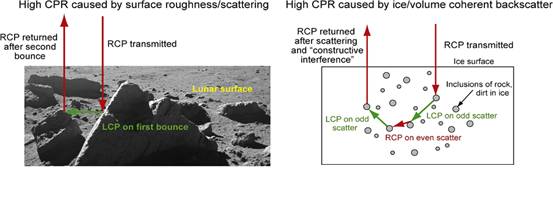





Published on Feb 14, 2025
The Miniature Radio Frequency (Mini-RF) system is manifested on the Lunar Reconnaissance Orbiter (LRO) as a technology demonstration and an extended mission science instrument. Mini-RF represents a significant step forward in space borne RF technology and architecture. It combines synthetic aperture radar (SAR) at two wavelengths (S-band and X-band) and two resolutions (150 m and 30 m) with interferometric and communications functionality in one lightweight (16 kg) package.
Previous radar observations (Earth-based, and one bistatic data set from Clementine) of the permanently shadowed regions of the lunar poles seem to indicate areas of high circular polarization ratio (CPR) consistent with volume scattering from volatile deposits (e.g. water ice) buried at shallow (0.1-1 m) depth, but only at unfavorable viewing geometries, and with inconclusive results. The LRO Mini-RF utilizes new wideband hybrid polarization architecture to measure the Stokes parameters of the reflected signal. These data will help to differentiate “true” volumetric ice reflections from “false” returns due to angular surface regolith.
Additional lunar science investigations (e.g. pyroclastic deposit characterization) will also be attempted during the LRO extended mission. LRO’s lunar operations will be contemporaneous with India’s Chandrayaan-1, which carries the Forerunner Mini-SAR (S-band wavelength and 150-m resolution), and bistatic radar (S-Band) measurements may be possible. On orbit calibration, procedures for LRO Mini-RF have been validated using Chandrayaan 1 and ground-based facilities (Arecibo and Greenbank Radio Observatories).
The LRO Mini-RF payload will address key science questions during the LRO primary and extended missions. These include exploring the permanently shadowed Polar Regions and probing the lunar regolith in other areas of scientific interest. The nature and distribution of the permanently shadowed polar terrain of the Moon has been the subject of considerable controversy. Previous earth based observations uses that when an incident circularly polarized radar wave is backscattered off an interface, the polarization state of the wave changes. For most surfaces, this leads to a return with more of an “opposite sense” (OC) polarization than a “same sense” (SC) polarization, so the circular polarization ratio (CPR=SC/OC) remains less than 1.

However, in weakly absorbing media (such as water ice) the radar signal can undergo a series of forward scattering events off small imperfections in the material, each of which preserves the polarization properties of the signal . Those portions of the wave front that are scattered along the same path but in opposite directions combine coherently to produce an increase in the SC radar backscatter .
This coherent backscatter effect leads to large returns in the same sense (SC) polarization and values for CPR that can exceed unity. Note that CPR > 1, while diagnostic of water ice, is not a unique signature for water ice. Very rough, dry surfaces have also been observed to have CPRs that exceed unity. The CPR may increase in such regions due to double‐bounce scattering between the surface and rock faces. In order distinguish between true ice and false ice mini RF technology will be helpful.
The Mini-RF observations are made possible within the mass and power constraints imposed by LRO via application of a number of technologies. Two key technologies are a wideband Microwave Power Module (MPM) based transmitter and a lightweight broadband antenna and polarization design.
The Mini-RF Instrument is comprised of the following elements:
(1) Antenna,
(2) Transmitter,
(3) Digital receiver/quadrature detector waveform synthesizer,
(4) Analog RF receiver,
(5) Control Processor,
(6) Interconnection module
(7) Supporting harness, RF cabling, and structures
The mini RF architecture is unique in planetary radar; it transmits right circular polarization radiation and receives the horizontal (H) and vertical (V) polarization components coherently, which are then reconstructed as Stokes’ parameters during the data processing step. Both the communications and the radar astronomical objectives impose a requirement for circular polarization on the transmitted field. Conventional radar that would measure CPR then would have to be dual-circularly polarized on receiver. The hybrid-polarity approach provides weight savings by eliminating circulator elements in the receiver paths, which reduces mass, increases RF efficiency, and minimizes cross-talk and other self-noise aspects of the received data. The H and V signals are passed directly to the ground-based processor.
1. www.spudislunarresources.com
2. www. lunar.gsfc.nasa.gov
3. www. ieeexplore.ieee.org
4. Ritchriya
5. NASA Fact
| Are you interested in this topic.Then mail to us immediately to get the full report.
email :- contactv2@gmail.com |